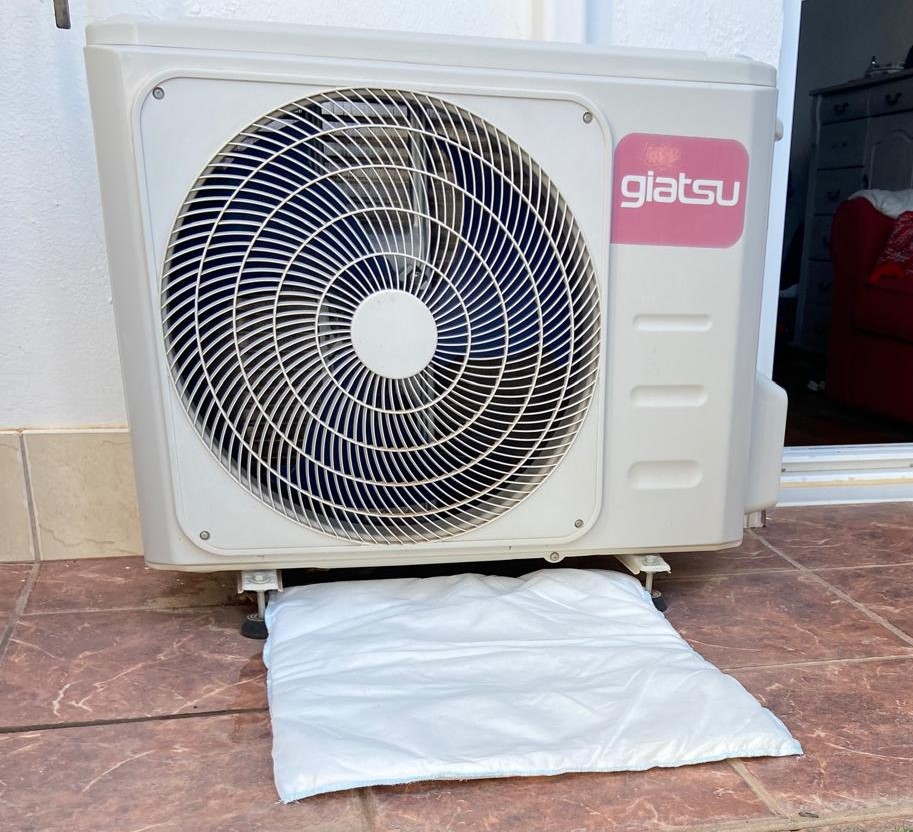Many people don’t realise that air conditioning units drip water which can quickly cause a health and safety hazard but there is a very quick and inexpensive way to solve the problem … and that’s with a single FloodSax.
They are multi-purpose and incredibly flexible and have a fantastic reputation worldwide as the original alternative sandbag – simply immerse them in water to transform them into a sandless sandbags.
But in their dry state FloodSax are very flat with a large surface area so are designed to soak up and retain water. One strategically placed beneath an air conditioning unit will catch the dripping water, preventing it from leaking onto tiles, instantly making them slippery. If the air conditioning unit develops a fault even more water can quickly leak out damaging floors, furniture, fixtures and fittings.
People try all kinds of ways to solve the problem – even using old trays to try to catch the drips – but they are far from ideal. No matter how hard you try to position a tray beneath air conditioning units, some water will continue to escape across the floor and the tray can quickly overflow too.
Air conditioning units naturally drip water because of the condensation that’s produced by the process of cooling a room and reducing humidity.
The air conditioner’s cooling coil absorbs moisture from the room which turns into liquid, collects on cold surfaces in the unit and then this starts to drip, usually from the back. The more humid it is, the more it’ll drip, and in a very hot climate it could leak up to two gallons a day.
There are many reasons air conditioning units can develop severe water escapes but the main ones include air leaks with the air not passing through the vents as it should, a blocked or dirty aircon filter, a broken condensation pump, the condensation pump blocked by dust and dirt, a blocked or broken condenser coil and a water drain line clogged by debris or mould.
Once water escapes on this scale it wrecks everything it touches, leading to damage that’s very expensive to repair.
There isn’t much room beneath some air conditioning units to catch this escaping water so nothing really fits snugly to do the job except FloodSax which absorbs the water in its internal gelling polymer and then retains it so it goes nowhere.
FloodSax are incredibly flexible so can be popped right under a unit and even wrapped around its legs to catch every last drop.
You’ll probably only need one FloodSax for a domestic air conditioning unit at any one time.
They can also be used on a far larger scale as they were when a row of FloodSax were placed around a faulty air conditioning system on the roof of a radio station’s building.
This stopped water getting in and seeping through ceilings which would have caused a colossal amount of damage inside.
FloodSax come in handy packs of five that are vacuum-packed and exceptionally space-saving to store. It means you’d only need to take a couple out in your luggage to pop under an air conditioning unit if you’re renting a place where the sun really does shine.
FloodSax are multi-purpose so can be put in the hardest-to-reach places to soak up leaks, spills, drips and internal floods in homes and businesses with the water being absorbed into the FloodSax’s super absorbent gelling polymer.
This can be beneath pipes, under sinks and below boilers and radiators – anywhere water can leak inside homes and businesses. They are used extensively in supermarkets both to prevent floods as instant sandbags and also to soak up water leaking in through roofs, windows and doors or from beneath faulty refrigeration units.
To transform a FloodSax into an alternative sandbag immerse it fully in water and the FloodSax will absorb and retain around 20 litres in its gelling polymer, transforming it into instant alternative ‘sandless’ sandbag in just 5 minutes or so. Their uniform shape means they can be built into temporary anti-flood barriers strong enough to keep out a torrent of floodwater.
To find out more about FloodSax in the US email us at info@floodsaxus.com, phone us on 800 255 4208 ext 121 or visit our website at https://www.floodsaxus.com/

